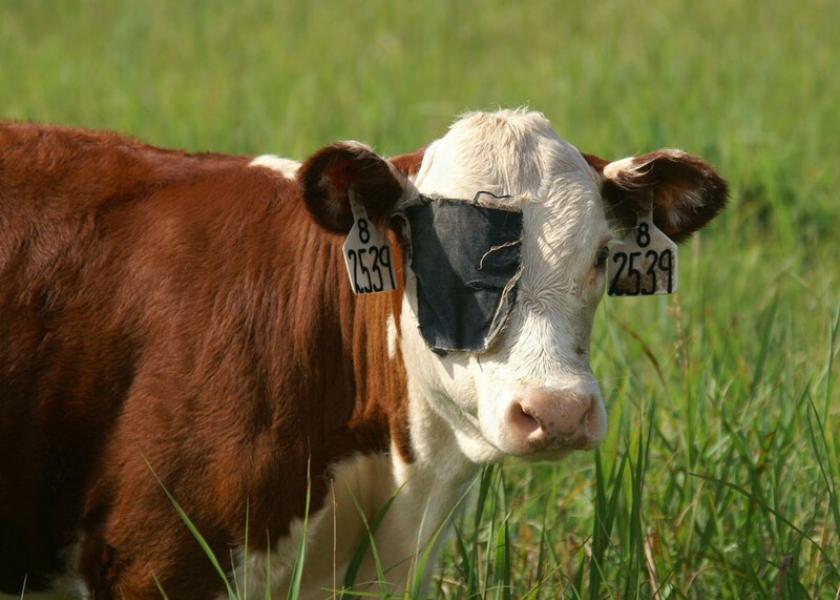The Impact of Pinkeye in Cattle: Causes, Signs, and Best Practices for Control and Prevention

Pinkeye, also known as infectious bovine keratoconjunctivitis, is a painful eye disease that affects cattle worldwide. It is more prevalent in cattle with light-colored faces and in environments with bright sunlight, dust, and certain other conditions. Outbreaks can occur at any time, but the risk is highest during the summer months.
Here’s a look at the causes, signs, treatment, control and prevention of pinkeye, provided by Kansas State University’s Beef Cattle Institute.
Cause of Pinkeye
Pinkeye is typically caused by minor eye injuries resulting from factors, including:
• bright sunlight
• dust
• wind
• tall grass or weeds
• plant seeds
• pollen
• face flies
• diseases like bovine rhinotracheitis (IBR)
If these injuries do not lead to an infection with pinkeye-causing germs, the animal may experience only a short period of irritation characterized by excessive tearing. However, if the injured eyes become infected, serious problems can arise, and it may be necessary to consult a veterinarian to determine whether the issue is due to pinkeye or another disease.
Various organisms can cause pinkeye infections, with the most common being Moraxella bovis. This bacterium possesses hair-like structures that enable it to attach to the eye's surface. Additionally, it produces an enzyme that destroys cells on the eye's surface.
Moraxella bovis can spread to other cattle through direct contact with eye discharges or via face flies, which carry the organism from one animal to another. Face flies are particularly involved in pinkeye transmission as they irritate the eyes of cattle, making them more susceptible to infection. They can pick up the organism while feeding on the face of infected animals and spread it to the eyes of other cattle within a herd.
Calves are believed to be more vulnerable to pinkeye than older animals due to their lack of immunity and their closer proximity to dust, pollen, and tall grass or weeds.
It is generally believed that cattle infected with a specific type of Moraxella bovis will not contract the disease again for over a year. However, there are different types or families of this bacterium, and immunity to one type does not guarantee protection against other types. Furthermore, other germs can also cause pinkeye infections, and previous immunity to Moraxella bovis infections does not safeguard against these infections.
Signs of Pinkeye
The initial sign of pinkeye is increased tearing, resulting in excessive wetness around the eyes. On closer examination, the inside lining of the eyelid and the white portion of the eye will appear red.
As the disease progresses, the eye may become cloudy or white. An ulcer often forms in the center of the visual portion of the eye, and if it becomes deep enough, the eye can rupture.
Without treatment, many animals will heal within 3 to 6 weeks. Some animals will heal without any evidence of previous issues, while more severely affected individuals may develop a white scar on the eye's surface, which may fade over time. Ruptured eyes will lead to blindness and severe disfigurement.
Treating Pinkeye
The best method of treating cattle with pinkeye involves administering antibiotic injections and reducing exposure to dust, weeds, and sunlight. Most strains of Moraxella bovis are susceptible to antibiotics that can be injected under the skin of the neck.
Covering the affected eye with a patch glued over the face or sewing the eyelids shut can help alleviate discomfort by reducing sunlight exposure and limiting the spread of the disease.
If possible, affected calves should be relocated to shaded areas with minimal dust exposure, where they can receive easy treatment. Adequate feed and water should be provided to the calves and their dams until they can be reintegrated with the rest of the herd once their eyes have healed.
Preventing and Controlling Pinkeye
Preventing and controlling pinkeye involves reducing exposure to environmental risk factors like dust, pollen, tall grass and weeds through effective pasture management. Face fly burden can be reduced by using chemical pesticides, and affected individuals should be isolated from the rest of the herd.
While it may seem that vaccination could be an effective prevention method due to the apparent immunity that develops after recovery from an infection and the higher level of natural immunity in older animals, vaccines have not proven to be particularly successful in preventing pinkeye. Although they provide partial protection, factors such as the ability of Moraxella bovis to change types, the presence of other organisms, or environmental conditions can hinder the vaccines' effectiveness.
Pinkeye is a frustrating disease for ranchers as they can experience years without problems, only to face a year where a high percentage of calves are affected without any apparent changes. Although vaccines are commonly used for protection, several factors work against their effectiveness. Treating pinkeye cases requires significant labor, particularly when calves are on pasture and difficult to capture individually. While no simple solutions exist, adopting strategies like good pasture management, effective fly control and early detection and treatment of eye problems can help minimize the impact of this disease.







